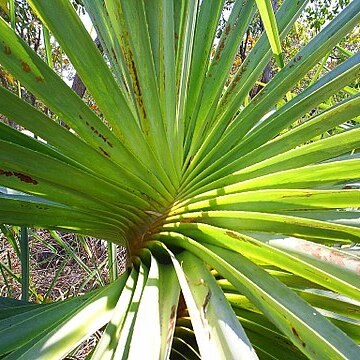A tree which grows to 10 m high. It has prickly leaves. The trunk is marked with leaf scars. It does not have prop roots. Trees are separately male and female. The leaves are crowded towards the ends of branches. They are arranged in spirals. They are stiff, leathery and V shaped. They are widest at the base and taper to the tip. Leaves are 1.5-2 m long by 4-7 cm wide. They are often bent downwards from about one third of their length. There are small thorns along the edge. The flowers occur as male and female flowers on separate plants. The flowers are small and white. They occur in dense spikes near the ends of branches. These spikes are 3-7 cm long and enclosed with bracts. The fruit are wedge shaped. They are woody. Fruit are 5-7 cm long by 5-8 cm wide and occur in clusters of 8-25. These heads are 15-20 cm across. They hang below the crown and are orange red when ripe. There are several varieties.


